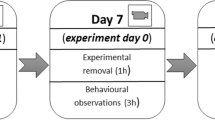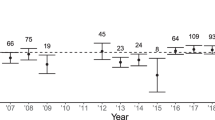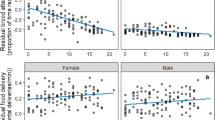Abstract
Previous studies of biparental care in birds have focused on the male’s contribution and experimental removal of males. Woodpeckers, with a high level of paternal care including nocturnal incubation and brooding by males, offer a meaningful system in which to examine the importance of care by females. I studied the reproductive performance of 17 widowed male and 8 widowed female northern flickers (Colaptes auratus) relative to biparental (control) pairs. Of these single parents all widowed shortly after hatching, only one female abandoned its nest. Single parents boosted their provisioning rates to achieve 83% the provisioning rate of control broods, but reared significantly fewer young and young of poorer quality. However, single males, with 85% of the reproductive success of controls, were more successful than females with 43% the success of controls. Among widowed birds, a not significant lower survival was observed, but the chance of re-pairing with the same partner in a subsequent year was only 16% in the natural population, so long-term costs of desertion may be small. Although females seem to have the incentive and ability to desert, a lack of available males may constrain opportunities. This study demonstrates that when parental care roles are reversed in altricial birds, asymmetric benefits can favor female and not male desertion.




Similar content being viewed by others
References
Alatalo RV, Lundberg A, Stahlbrandt K (1982) Why do pied flycatcher females mate with already mated males? Anim Behav 30:585–593
Barba E, Gil-Delgado JA, Monros JS (1995) The cost of being late: consequences of delaying great tit Parus major first clutches. J Anim Ecol 64:642–651
Bart, J, Tornes A (1989) Importance of monogamous male birds in determining reproductive success- evidence for house wrens and a review of male-removal studies. Behav Ecol Sociobiol 24:109–116
Beissinger SR (1986) Demography, environmental uncertainty and the evolution of mate desertion in the snail kite. Ecology 67:1445–1459
Beissinger SR, Syder NFR (1987) Mate desertion in the snail kite. Anim Behav 35:477–487
Björkland M, Westman B (1986) Adaptive advantages of monogamy in the great tit (Parus major): and experimental test of the polygyny threshold model. Anim Behav 34:1436–1440
Bowman R, Bird DM (1987) Behavioral strategies of American kestrels during mate replacement. Behav Ecol Sociobiol 20:129–135
Burley N (1980) Clutch overlap and clutch size: alternative and complementary reproductive tactics. Am Nat 115:223–246
Chase ID (1980) Cooperative and non-cooperative behavior in animals. Am Nat 115:827–857
Chek AA, Robertson RJ (1991) Infanticide in female tree swallows: a role for sexual selection. Condor 93:454–457
Clutton-Brock TH (1991) The evolution of parental care. Princeton University Press, Princeton, N.J.
Davies NB (1985) Cooperation and conflict among dunnocks, Prunella modularis, in a variable mating system. Anim Behav 33:628-648
Dawkins R, Carlisle, TR (1976) Parental investment, mate desertion and a fallacy. Nature 262:131–133
Dickinson JL, Weathers WW (1999) Replacement males in the western bluebird: opportunity for paternity, chick-feeding rules, and fitness consequences of male parental care. Behav Ecol Sociobiol 45:201–209
Duckworth JW (1992) Effects of mate removal on the behaviour and reproductive success of reed warblers Acrocephalus scirpaceus. Ibis 134:164–170
Dunn PO, Hannon SJ (1989) Evidence for obligate male parental care in black-billed magpies. Auk 106:635–644
Dunn PO, Hannon SJ (1992) Effects of food abundance and male parental care on reproductive success and monogamy in tree swallows. Auk 109:488–499
Dunn PO, Robertson RJ (1992) Geographic variation in the importance of male parental care and mating systems in tree swallows. Behav Ecol 3:291–299
Eens, M, Pinxten R (1995) Mate desertion by primary female European starlings at the end of the nestling stage. J Avian Biol 26:267–271.
Elchuk CL (2002) Home range, territoriality and foraging site selection of the northern flicker (Colaptes auratus). MSc Thesis, University of Saskatchewan, Saskatoon
Elchuk CL, Wiebe KL (2002) Food and predation risk as factors influencing foraging locations of northern flickers (Colaptes auratus). Wilson Bull 114:349–357
Eldegard K (2003) Parental care and offspring desertion in Temgmalm’s owl (Aegolius funereus) and sparrowhawk (Accipter nisus). DSc Thesis, Agricultural University of Norway, Oslo
Emlen ST, Oring LW (1977) Ecology, sexual selection and evolution of mating systems. Science 197:215–223
Freeman-Gallant CR (1998) Fitness consequences of male parental care in savannah sparrows. Behav Ecol 9:486–492
Gowaty PA (1983) Male parental care and apparent monogamy among eastern bluebirds (Sialia sialis). Am Nat 121:149–157
Gowaty PA (1996) Battles of the sexes and the origins of monogamy. In: Black JM (ed) Partnerships in birds, the study of monogamy. Oxford University Press, Oxford, pp 21–51
Greenlaw JS, Post W (1985) Evolution of monogamy in seaside sparrows, Ammodramus maritimus: tests of hypotheses. Anim Behav 33:373–383
Houston AI, Davies NB (1985) The evolution of cooperation and life history in the dunnock, Prunella modularis. In: Sibly R, Smith R (eds) Behavioural ecology: the ecological consequences of adaptive behaviour. Blackwell, Oxford, pp 471–487
Ketterson ED, Nolan V Jr (1994) Male parental care in birds. Annu Rev Ecol Syst 25:601–28
Lack D (1968) Ecological adaptations for breeding in birds. Methuen Press, London
Ligon JD (1993) The role of phylogenetic history in the evolution of contemporary avian mating and parental care systems. Curr Ornithol 10:1–46
Ligon JD (1999) The evolution of avian breeding systems. Oxford University Press, New York
Lynn SE, Wingfield JC (2003) Male chestnut-collared longspurs are essential for nestling survival: a removal study. Condor 105:154–158
Lyon BE, Montgomerie RD, Hamilton LD (1987). Male parental care and monogamy in snow buntings. Behav Ecol Sociobiol 20:377–382
Markman S, Yom-Tov Y, Wright J (1996) The effect of male removal on female parental care in the orange-tufted sunbird. Anim Behav 52:437–444
Maynard Smith J (1977) Parental investment: a prospective analysis. Anim Behav 25:1–9
Meek SB, Robertson RJ (1994) Effects of male removal on the behavior and reproductive success of female eastern bluebirds Sialia sialis. Ibis 136:305–312
Mock DW, Fujioka M (1990) Monogamy and long-term pair bonding in vertebrates. Trends Ecol Evol 5:39–45
Møller AP (1988) Infanticidal and anti-infanticidal strategies in the swallow Hirundo rustica. Behav Ecol Sociobiol 22:365–371
Moore W L (1995) The northern flicker (Colaptes auratus). In: Poole A, Gill F (eds) The birds of North America, No. 166. The Birds of North America, Philadelphia, Pa.
Murray BG Jr (1984) A demographic theory on the evolution of mating systems as exemplified by birds. In: Hecht MK, Wallace B, Prance GT (eds) Evolutionary biology, vol. 18. Plenum, New York, pp 71–140
Orians GH (1969) On the evolution of mating systems in birds and mammals. Am Nat 103:589–603
Owens IPF (2002) Male-only care and classical polyandry in birds: phylogeny, ecology and sex differences in remating opportunities. Philos Trans R Soc Lond B 357:283–293
Owens IPF, Bennett PM (1997) Variation in mating system among birds: ecological basis revealed by hierarchical comparative analysis of mate desertion. Proc R Soc Lond B 264:1103–1110
Persson O, Öhrström P (1989) A new avian mating system: ambisexual polygamy in the penduline tit Remiz pendulinus. Ornis Scand 20:105–111
Pinxten R, Eens M, Verheyen RF (1995) Response of male European starlings to experimental removal of their mate during different stages of the breeding cycle. Behaviour 132:301–317
Pyle PS, Howell NG, DeSante DF, Yunick RP, Gustafson M (1997). Identification guide to North American birds. Part 1. Columbidae to Ploceidae. Slate Creek, Bolinas, Calif.
Richmond AW (1978) An experimental study of advantage of monogamy in the cardinal. PhD dissertation, Indiana University, Bloomington
Roulin A (2002) Offspring desertion by double-brooded female barn owls (Tyto alba). Auk 119:515–519
Rowley I (1983) Remating in birds. In: Bateson P (ed) Mate choice. Cambridge University Press, London, pp 331–360
Sasvari L (1986) Reproductive effort of widowed birds. J Anim Ecol 55:553–564
Slagsvold T, Lifjeld J (1994) Polygyny in birds: the role of competition between females for male parental care. Am Nat 143:59–94
Smith JNM, Yom-tov Y, and Moses R (1982) Polygyny, male parental care and sex ratio in song sparrows: an experimental study. Auk 99:555–564
Solheim R (1983) Bigyny and biandry in the Tengmalm’s owls Aegolius funereus. Ornis Scand 14:51–57
SPSS (1998) SPSS for windows: base system’s users guide. Release 11.0 SPSS Chicago, Ill.
Stacey PB, Edwards T (1983) Possible cases of infanticide by immigrant females in a group-breeding bird. Auk 100:731–733.
Székely T, Webb JN, Houston AI, McNamara JM (1996) An evolutionary approach to offspring desertion in birds. Curr Ornithol 13:271–330
Trivers RL (1972) Parental investment and sexual selection. In: Campbell BG (ed) Sexual selection and the descent of man. Aldine, Chicago, pp 136–179
Valera F, Hoi H, Schleicher B (1997) Egg burial in penduline tits, Remiz pendulinus: Its role in mate desertion and female polyandry. Behav Ecol 8:20-27
Weatherhead PJ (1979) Ecological correlates of monogamy in tundra-breeding savannah sparrows. Auk 96:391–401
White GC, Burnham KP (1999) Program MARK: survival estimation from populations of marked animals. Bird Study 46:S120–139
Wiebe KL (2001) Microclimate of tree cavity nests: is it important for reproductive success in northern flickers? Auk 118:412–421
Wiebe KL (2002) First reported case of classical polyandry in a North American woodpecker, the northern flicker. Wilson Bull 114:401–403
Wiebe KL (2003) Delayed timing as a strategy to avoid nest-site competition: testing a model using data from starlings and flickers. Oikos 100:291–298
Wiebe KL, Elchuk CL (2003) Correlates of parental care in northern flickers Colaptes auratus: do the sexes contribute equally when provisioning young? Ardea 91:91–101.
Wiktander U, Olsson O, Nilsson SG (2000) Parental care and social mating system in the lesser spotted woodpecker Dendrocopos minor. J Avian Biol 31:447–456
Winkler DW (1987) A general model for parental care. Am Nat 130:526–543
Wolf L, Ketterson ED, Nolan V Jr (1988) Paternal influence on growth and survival of dark-eyed junco young: do parental males benefit? Anim Behav 36:1601–1618
Wolf L, Ketterson ED, Nolan V Jr. (1990) Behavioural response of female dark-eyed juncos to the experimental removal of their mates: implications for the evolution of male parental care. Anim Behav 39:125–134
Acknowledgments
Thanks to P. Gowaty, T.A. Slagsvold and anonymous reviewers for comments on the manuscript. C.L. Elchuk and numerous field assistants over the years have helped to find and monitor flicker nests. K. Martin and F. Cooke were generous in sharing field camp facilities. The study was funded by an NSERC research grant.
Author information
Authors and Affiliations
Corresponding author
Additional information
Communicated by: I. Hartley
Rights and permissions
About this article
Cite this article
Wiebe, K.L. Asymmetric costs favor female desertion in the facultatively polyandrous northern flicker (Colaptes auratus): a removal experiment. Behav Ecol Sociobiol 57, 429–437 (2005). https://doi.org/10.1007/s00265-004-0878-2
Received:
Revised:
Accepted:
Published:
Issue Date:
DOI: https://doi.org/10.1007/s00265-004-0878-2




